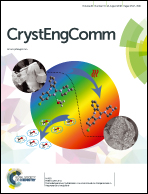Halo-methylphenyl substituted neutral tripodal receptors for cation-assisted encapsulation of anionic guests of varied dimensionality†
Abstract
Aromatic tripodal anion receptors derived from either flexible [tris(2-aminoethyl)-amine], tren skeletons or any other benzene-based rigid platforms reported from the beginning of anion recognition chemistry contain either electron-withdrawing group/s, electron-donating group/s or zero substituents at the terminal aromatic rings. In this report, we have rationally designed and synthesized two tren-based halo-methylphenyl disubstituted tris-urea receptors, which have one electron-withdrawing halide group (chloro/bromo) as well as one electron-donating methyl group at their terminal aromatic rings. The tris([(3-chloro-4-methylphenyl)amino]ethyl)-urea receptor, L1, efficiently captures spherical chloride and bromide anions in complexes 1a and 1b, respectively, via 1 : 1 cation-sealed host–guest encapsulation, whereas its isomeric tris([(4-bromo-3-methylphenyl)amino]ethyl)-urea receptor, L2, encapsulates the smallest halide anion in complex 2avia formation of unimolecular polymeric host–guest assemblies. In contrast, planar carbonate, tetrahedral sulphate and octahedral hexafluorosilicate anions of varied dimensionalities are engulfed inside the dimeric capsular cages of either of the isomeric neutral receptors L1 or L2 in 2 : 1 host–guest fashion, irrespective of the size of the countercations in complexes 1c, 1d, 2b or 2c.



 Please wait while we load your content...
Please wait while we load your content...